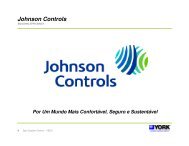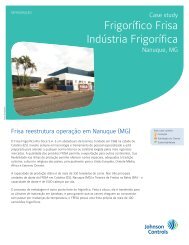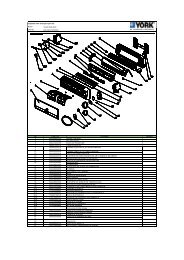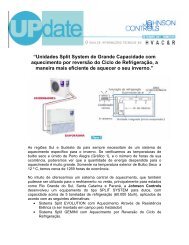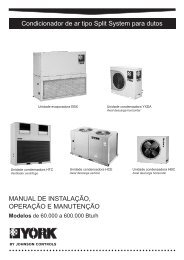Manual Técnico - Chiller YORK® Absorção YPC ... - Johnson Controls
Manual Técnico - Chiller YORK® Absorção YPC ... - Johnson Controls
Manual Técnico - Chiller YORK® Absorção YPC ... - Johnson Controls
You also want an ePaper? Increase the reach of your titles
YUMPU automatically turns print PDFs into web optimized ePapers that Google loves.
FORM 155.17-EG4<br />
The burner is made of welded steel and the combusion<br />
head incorporates a multi-blade stainless steel, flame<br />
retention diffuser. Minimum turndown ratio is 3 to 1.<br />
Combustion air is supplied by an integrally-mounted<br />
blower assembly incorporating a direct-drive, 3-phase<br />
motor. The burner uses a full-modulation-type fuel/air<br />
control system.<br />
The gas control train is prepiped and prewired with suitable<br />
junction boxes and terminal strips to burner panel<br />
terminal connections. The gas train contains the following<br />
components: manual shutoff cock, main gas pressure<br />
regulator, low and high gas pressure switches, two<br />
(2) UL listed leak test cocks, burner manifold gas pressure<br />
gauge, two (2) main motorized gas valves (for gas<br />
inputs of 5.0 MMBTU/HR and lower), two (2) main motorized<br />
gas valves – one (1) with proof of closure interlock<br />
switch (for gas inputs above 5.0 MMBTU/HR), and<br />
one (1) normally open vent valve sized according to IRI<br />
requirements.<br />
The oil control train (when specified) incorporates U.L.<br />
approved components supplied by the burner manufacturer<br />
to provide the specified fuel/air control operation.<br />
The system uses a single high pressure oil nozzle<br />
of the internal-bypass type. The nozzle oil train includes<br />
one (1) 300# (2.1 MPa) gauge to read nozzle return oil<br />
pressures.<br />
The high pressure nozzle supply oil pump is a two (2)<br />
gear type capable of producing 300 PSIG (2.1 MPa) discharge<br />
pressure and 15 inches (381 mm) Hg. vacuum. It<br />
is a separate unit mounted on its own support base with a<br />
direct drive motor. The oil pump unit comes complete with<br />
removable mesh-type oil strainer, 0-300 PSIG (2.1 MPa)<br />
oil nozzle pressure gauge, nozzle line, main and auxiliary<br />
solenoid safety shutoff oil valves and low oil pressure<br />
switch. The oil nozzle bypass line uses dual check valves.<br />
The flame safeguard control includes fully automatic<br />
prepurge and post-purge sequencing of the burner blower<br />
motor, interrupted ignition system, and fuel/air flow components<br />
with an ultra violet sensor for flame detection.<br />
Pumps<br />
Solution and refrigerant pumps are hermetically sealed,<br />
self-lubricating, totally enclosed, liquid cooled,<br />
factory-mounted, wired and tested. Motor windings are not<br />
exposed to LiBr or water. The suction and discharge connections<br />
for each pump are fully welded to the unit piping<br />
to minimize the opportunity for leaks. Suction and discharge<br />
connections are also equipped with factory installed isolation<br />
valves to permit quick and easy servicing of pumps.<br />
AII <strong>YPC</strong> units include one or two solution pump(s) and a<br />
refrigerant pump. Pumps are designed to operate for a<br />
total of 55,000 hours between service inspections.<br />
Valves<br />
All valves used for adjusting the solution are fully welded<br />
or brazed to prevent leakage of air into the unit. Valve<br />
actuators are covered with a seal cap to eliminate the<br />
possibility of air leakage through the stem. Additionally,<br />
all connections of valves to unit piping are fully welded.<br />
Solution and Refrigerant<br />
Each Millennium unit is charged with lithium bromide<br />
solution with non-toxic lithium molybdate as a corrosion<br />
inhibitor. Refrigerant is deionized water. A small amount<br />
of 2-ethyl hexanol is added as a heat and mass transfer<br />
enhancer.<br />
Purge System<br />
The purge system automatically and constantly removes<br />
noncondensible vapors generated in the absorption process<br />
through the use of an eductor. Noncondensibles<br />
are then stored in a purge chamber until they can be<br />
removed through the use of a purge pump. The purge<br />
pump is an oil, rotary, two-stage vacuum pump with a<br />
1/4 HP, 3-Phase, ODP motor.<br />
The chiller control panel includes a SmartPurge system<br />
that will automatically sense the amount of noncondensibles<br />
in the purge chamber and empty the tank<br />
whenever necessary. The SmartPurge system eliminates<br />
the need for an operator to ever manually empty the purge<br />
chamber. In addition, the control panel monitors the frequency<br />
of purge cycles and alerts the chiller operator,<br />
through a unique control panel warning message, if the<br />
number if purges exceeds normal levels.<br />
Capacity Control<br />
Capacity control is accomplished by modulating the<br />
burner’s firing rate. The <strong>YPC</strong> Direct-Fired unit is capable<br />
of modulating capacity from 30% to 100%.<br />
The two-stage chiller design incorporates a float valve<br />
that limits solution flow to the generator as the cooling<br />
load decreases. This maintains optimum solution level<br />
throughout the operating range. In addition, manual control<br />
valves are used by YORK technicians in the factory<br />
and/or at start-up to fine tune solution and refrigerant<br />
flows to match the jobsite needs at peak efficiency.<br />
Power Panel<br />
The power panel enclosure includes the following: single<br />
point wiring connection for the incoming power supply;<br />
non-fused disconnect switch; motor starters, complete<br />
with current and thermal-overload protection for solution<br />
pump(s), refrigerant pump, and purge pump (current<br />
overloads only); 115VAC 50/60 Hz control power<br />
transformer.<br />
YORK INTERNATIONAL<br />
13


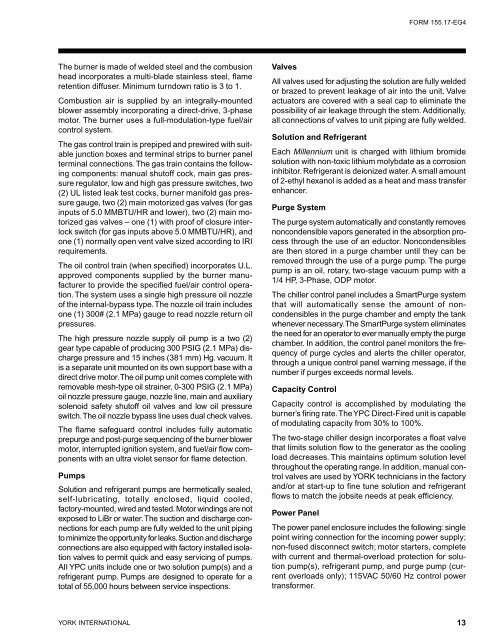
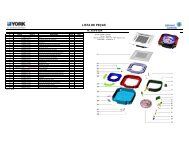

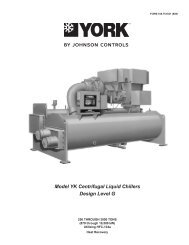
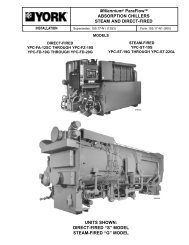
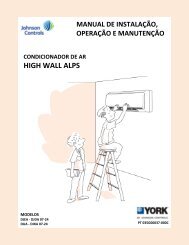
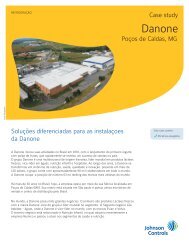
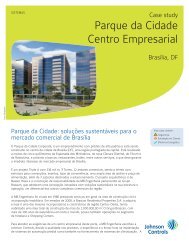

![[PDF] Catálogo Técnico YP Corrigido Corel 9 - Johnson Controls](https://img.yumpu.com/49244478/1/190x245/pdf-catalogo-taccnico-yp-corrigido-corel-9-johnson-controls.jpg?quality=85)

